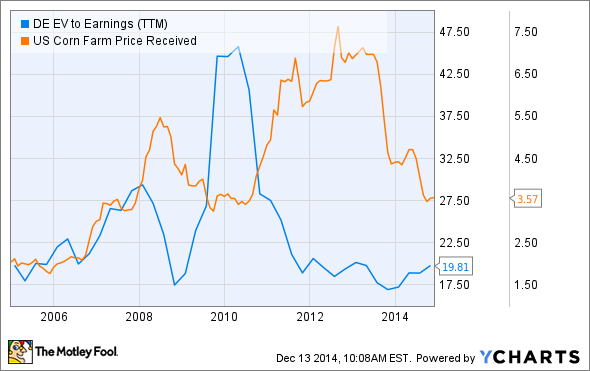Deere & Company (DE -0.33%) investors must make up one of the broadest of churches in the investing world. Commodity followers are looking for a cyclical bounce in crop prices next year. Meanwhile, income seekers are enjoying its near 2.5% dividend yield. However, the question for long-term investors is whether now is the time to initiate a position in Deere & Company stock?
A good strategic fit for your portfolio
Before discussing the underlying fundamentals with the company, a few words on why Deere is attractive for your portfolio. Simply put, the stock's prospects are tied to the price movements in the key crops its agricultural machinery services. When important crops like corn, wheat, cotton, and soybeans go up in price, farmers tend to make more income, and then use part of it to invest in new machinery -- good news for Deere.
In other words, by buying Deere, you are buying a stock whose prospects are not necessarily tied to the economy -- a good way to achieve diversification. Put it this way, if you hold 10 stocks whose prospects are tied to GDP growth, then you shouldn't be surprised if your portfolio underperforms when economic growth disappoints. A stock like Deere gives you the opportunity to escape this kind of correlated performance. With that said, a stock has to be a good value in itself before it forms a part of anyone's portfolio. Time to look at Deere's prospects.
A tough year ahead; a trough year ahead?
Of course, a cyclical stock is usually a better investment proposition if bought before the budding shoots of recovery start to come up. Unfortunately, this is easier said than done -- it requires a view on crop prices. In fact, Management's forecast for a 15% drop in net sales in 2015 is a reflection of ongoing weakness in some key crop prices.
U.S. Corn Farm Price Received data by YCharts.
Indeed, partly thanks to the strong crop harvest of 2014, Deere's management expects crop prices to weaken further in 2015. While, sales conditions look likely to be difficult next year for Deere, and competitors like CNH Industrial (CNHI -1.04%) and AGCO Corporation (AGCO -0.42%) appear to be less well prepared than Deere, the real question is whether crop prices will trough next year. Moreover, how is Deere prepared?
In trying to answer this question, readers are invited to look at the bullish and bearish cases for the stock in the articles linked. The key arguments are summarized in the table below.
| Bull Case | Bear Case |
| Management believes just "normal" weather in 2015 could see crop prices rise. | Deere's production volumes could go below the range that the company is structured to deal with. |
| Farmers expected to reduce corn acreage in 2015; prices could rise afterwards. | No guarantee that farmers will reduce acreage, and separately, yields could continue their strong uptrend. |
| Deere has made early adjustments (reducing inventory, cutting costs) in preparation for lower sales. | Deere's competitors could cut prices in order to clear their own inventory. |
| Credit conditions remain favorable, farmers have access to credit. | Deere could find it tough to realize its planned 2% price increase. |
On balance, I think the bullish case is stronger. However, I would not be surprised to see conditions get worse before they get better for Deere. Moreover, the exact timing of any upturn in crop prices -- an event that would surely be priced in to Deere's stock price in short time -- is subject to uncertainty.
The good news is that the valuation on the stock is somewhat supportive. For example, here is a chart of its enterprise value, or EV, to earnings ratio in the last decade. EV (market cap plus net debt) is a useful measure, because it accounts for debt. The last time that Deere hit a significant trough in earnings was during 2009-2010, when its EV/earnings ratio hit 45 times.
For 2015, Deere's management is forecasting $1.9 billion in net income. If Deere hits this estimate for net income next year, then its forward EV/Earnings ratio -- at current share count and debt levels -- would be around 34 times, a figure significantly below the 45 times ratio discussed above.
DE EV to Earnings (TTM) data by YCharts.
There are two things to note from the following chart. First, the trough in net income -- if that's what it turns out to be -- is a lot higher than $874 million recorded in 2009. Second, net income margin looks like it could be a lot higher during this trough.

Source: Morningstar Research, author's analysis.
Where next for Deere & Company?
All told, the case for higher 2015 to be a trough earnings year looks like a good one, and if Deere hits its earnings estimate, then the stock looks attractive. However, its end market conditions could get worse before they get better, and it's far from clear how its competitors will react to an environment of falling sales in 2015. Cautious investors may want to wait for key crop prices to stop falling before buying in.






